If you're willing to work for it, Transistor's engaging world will reward you immensely
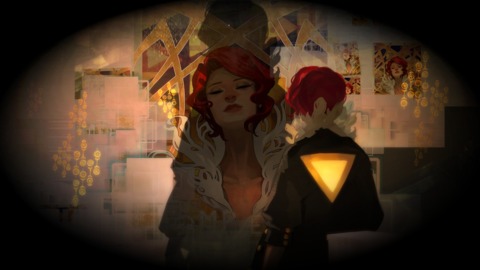
Transistor takes place in the city of Cloudbank, a futuristic utopia that is ever-changing due to the whims of its people. Each person has a say in everything from future public works to the color of the sky--and of course, popular opinion rules the day. For most residents, this is the perfect life, one where the city takes care of all their needs and everything is decided for them. For others, it is an eternal hell devoid of individuality. This group believes the old world must come to an end before all traces of originality die out.
You play as Red, a famous singer who dazzles the city with her compositions. She is one of those contented citizens of Cloudbank, going about her life happily with her unnamed lover. That all changes one night when she is attacked in her dressing room after a show by a mysterious group called the Camerata. In the chaos that follows, she manages to escape--but not without consequence: Red’s lover is killed with a strange sword and her voice has been stolen away. In return, however, she has claimed control of the Transistor, a blade which is now imbued with the voice and soul of her lover. With it, she can find the Camerata and obtain the answers she seeks.
Transistor dumps you into its world with just a small amount of information, expecting you to mostly figure things out for yourself from that point forward. Other than a basic idea of what you’re trying to do, there is very little context for anything around you. You will be bombarded with terms like the Process, Traces, and the Country with next-to-no idea what the hell they even mean. Characters seem to do things almost without motivation. The game really doesn’t want to just outright tell you anything about the world; instead, it forces you to pay attention to everything you find in order to figure it all out.
I found this a fascinating storytelling technique. As refreshing as it is to play a game that doesn’t heap a bunch of backstory into your face from minute one, Transistor was a bit overwhelming for me at first. I struggled to relate to anything and was constantly confused. Still, there was something there that intrigued me. I pushed forward and forced my brain to make the connections between characters, to infer what certain terms meant, to grasp the subtext of a conversation. This struggle could have been frustrating, but I found it endlessly endearing. It made me feel crazy smart when I managed to put everything together. By the end of my second playthrough, I felt like I understood the world entirely; better yet, I felt like I had earned this understanding.
That’s not to say I didn’t have a few issues with Transistor’s story. Red is a pretty bland and uninteresting character, mostly due to the fact that you never get a good sense of who she really is. Obviously, she never talks during the game since she’s lost her voice. Other than a small bio, all you get from her is the slightly snarky things she types into the game’s various terminals. Even these can be hard to read as her tone seems wildly inconsistent, ranging from sarcastic to timid.
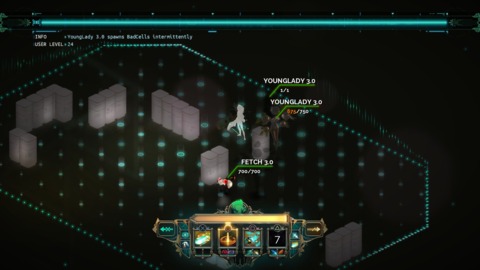
The bigger problem is the game’s ending. For an otherwise sharply written game, it feels unbelievably cliched and foolish. It left me slightly pissed off that there wasn’t more to it, an unsightly blemish in an otherwise creative narrative. This ending reinforced my notion that Transistor is captivated with the world it builds, perfectly willing to let the plot be simple and a bit clunky. In the end, I found myself agreeing: the world is infinitely more interesting than the plot.
In Transistor, you get to explore the city of Cloudbank as you attempt to accomplish various objectives. The game is fairly linear, leading you by the hand down smallish areas one-by-one until the game’s conclusion. Once or twice, I felt that the way forward was hard to discern, partially due to the game’s art style where layers often overlap one another and can obscure certain paths. There are a few things to find scattered about, mostly objects to inspect (with some VO from your sword pal) or terminals that give a bit of flavor to the world. For the most part, it’s extremely straightforward.
The meat of the game is the combat. Red often must fight the Process, a robotic force that has been corrupted by the Camerata, in order to progress forward. You can do this in real-time if you like, but nearly every ability you acquire has some kind of delay between pressing the button and actually coming out. You are also quite vulnerable, much squishier than the enemies; a straight brawl will rarely end in your favor, especially at first. Instead, it is preferable to use the Turn system, a skill that pauses the action and allows you to plan out your moves in a strategic manner. You can move around and queue up a few abilities before unpausing the action and performing it all at once. Most of your fights will, and should, be fought in this way.
Any time outside of Turn will have you avoiding enemy attacks before you can get into position for another volley of attacks. These foes are aggressive and dangerous when you aren’t in Turn, as many of them are faster and stronger than you are. At times, playing keepaway with a particularly rough enemy can be frustrating, desperately waiting out the clock to use Turn again. Certain battle arenas lack good cover which adds to the frustration. Thankfully, this difficulty does slowly even out as the game progresses, since you become tougher and have additional combat options.
Pausing time doesn’t make every encounter a breeze. The Turn meter is limited, meaning you can only do so much with it at once, and it has a slight cooldown before becoming useable again. Also, enemies aren’t entirely defenseless. Some can cloak, making them impossible to attack until they reappear. Others can dodge an attack or teleport away when in danger. It’s possible to accidentally knock enemies out of the way of further attacks, if you aren’t careful. Successful encounters rely on your ability to strategically balance this information and attack as effectively as possible. Poor planning will make your fights a lot more difficult in the long run.
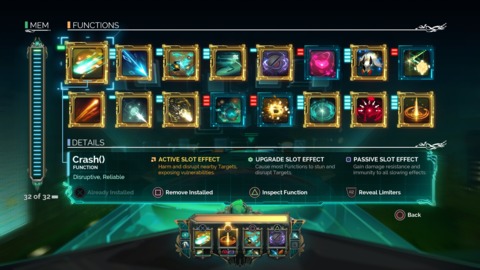
After a fight is finished, you earn a bit of XP, eventually gaining a new level. Leveling up gives you a few choices. Nearly every level will earn you a new Function, the abilities that make up your attack options. Every so often, you will additionally earn secondary bonuses, such as new passive slots for your abilities or extra memory so you can use even more Functions. It’s a very light leveling system, but it provides you with options that can make the combat potentially easier. Enemies level up too as you progress through the game, gaining new abilities to better fight you.
You also eventually unlock Limiters, which make the game harder in exchange for an experience bonus. Some of these are extremely mean-spirited, such as one that temporarily hinders your ability to alter your build, and increase the challenge substantially. I turned on all ten for the required trophy and took nearly an hour and a half to make it through the five fights it asks you to complete. Afterwards, when I turned them off, I found myself laughing at how much easier the normal game felt. It’s a substantial difference, one that shouldn’t be taken lightly. These Limiters are absolutely optional (unless you are an achievement hunter) but can be a good way to increase the difficulty if you want additional challenge
Once you have some new Functions, you can find an Access Point and play around with your build. There are four active skill slots, each of which come with two upgrade slots, and four passive slots. Every Function has different effects when put into any of these slots. Your first ability, Crash, is a debilitating, stunning strike when placed into an active slot but changes to an armor-increasing buff when placed in a passive slot. Every Function costs a set amount of memory, which you have to balance with your total amount (which increases as you level). There is an astounding amount of depth in combining these various abilities with one another; it’s likely that your preferred builds will be very different from the ones I used in my playthroughs.
Similar to the way the story works, Transistor dumps you into this Function system without explaining much. It’s a lot to take in at first, numbers and stats packed onto the screen in a way that doesn’t make much sense. It encourages you to read the effects and play around with different combinations to figure things out on your own. Again, this can be a bit annoying at first, but I actually found it to be rather smart. I felt much more badass coming up with a devastating combo because I knew I puzzled it out on my own.
There’s another good reason to play around with your build. Every Function represents an individual, part of their Trace (essentially their soul, in the game’s parlance). All the main players in the story, including Red, are represented by a Function, with the rest being minor characters whose inclusion makes sense later on. By using their Function in all of the three slot types (active, upgrade, and passive), you fill out a bio that gives you a bit of (mostly non-essential, but interesting) information about them. Similarly, all of the Limiters represent one of the game’s enemies and using them gives you a bit of info about what exactly their nature is. All of this information only requires one successful battle with the requisite ability in place to unlock, but it can take some time to do so with all sixteen of the Functions and all ten of the Limiters. Still, these bios can be very interesting, especially if you are fully engaged in the world.
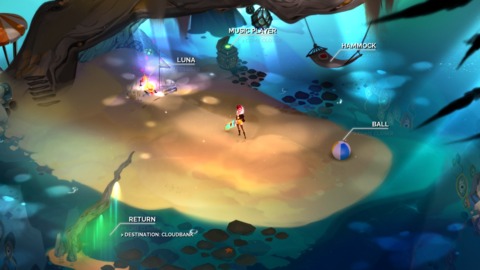
If you want to take a break from the story, you can hope into one of Transistor’s challenge rooms to test your combat skills. There are five types of tests to choose from, with further instances of each opening up as you both complete them and progress through the game. My favorite were easily the Planning tests, which force you to kill all the given enemies with a pre-determined skill set and one single use of Turn. These challenges felt the most creative and made my mind work the hardest. Sadly, this type is also the one with the fewest number of challenges and doesn’t get as crazy as I would have liked. I could see the potential for some devious puzzles, possibly in some DLC?
My least favorite were the Performance tests, which task you with fighting several waves of enemies by steadily giving you more Functions and memory to work with. The worst part about these tests is that which Functions you are given is entirely random; a string of bad luck can leave you with some less than optimal choices, forcing a restart. These tests are also the longest, the final one being fifteen waves of combat back-to-back. Failing in the final wave means doing all of them over again. I enjoyed these challenges every so often, as they were a nice break from the story. Doing them all back-to-back, however, is not recommended; it might take you quite some time to do so.
Once you complete the game, you are given the option to initiate Recursion, which is just a fancy way of saying New Game Plus. It drops you back at the beginning but with your level and unlocked Functions carrying over. The enemies likewise scale up in difficulty, gaining new abilities and strategies to test your skills. If you wish to hit max level or unlock all the challenges, you will have to experience most of this second playthrough. If you finish the game again, you can Recurse even further. I personally chose to stop at this point, so I don’t actually know if the enemies continue to grow in power.
I enjoyed the mix of real-time and strategic combat in Transistor. It inspired me to experiment with my builds and really learn the ins-and-outs of both the Turn system and the enemies behaviors. There were a few problems I had, though. Some enemies felt inconsistent, dodging some attacks on cue and failing to do so on others. I could never discern what variables were at work. There is also a bit of information about the game’s systems that is a bit too cryptic. For example, I don’t think it ever notes that your highest memory function is overloaded first when you fall in combat. This is one area where I felt that the game should have been a little more forthcoming. Finally, there is no way to access the Function menu outside of an Access Point. For the most part, this didn’t bother me. During certain challenges that give you preset abilities, however, I would have liked to actually inspect what I had equipped. These are all rather small, nitpicky complaints, but they were frustrating to deal with as I learned to play the game.
Transistor is an absolutely gorgeous game, dripping with atmosphere at every turn. I fell in love with every part of it, everything from the style of the architecture to the chosen color palettes in various areas. Every character is sharply drawn and perfectly unique; especially Red, who has become one of my favorite character designs to date. Each level looks quite different from the last, a visual treat to snack on while fighting the Process. Even the designs of the enemies is fascinating, representing various facets of their true nature. I loved how everything was so dedicated to the computer theme, like the fact that your abilities are called Functions or how the enemies increase in version number as they grow stronger in power. It is all so breathtakingly presented that I was utterly enthralled by every visual detail.
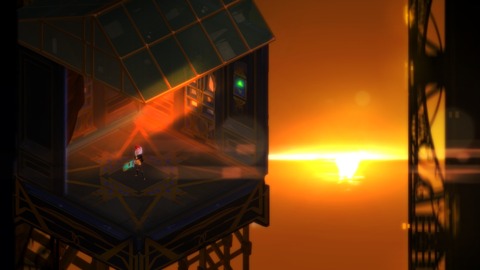
Even more squee-worthy were all the little details that are packed into the game. There is tons of filler text on examinable objects that just say things like how many people have viewed a painting or the average number of occupants in a rooftop bath. It doesn’t have much point, but it makes the world feel like a real place. I found it amusing that all the enemies have cheeky little names like Jerk or Creep, as if Red was annoyed with them and named each herself. There’s a needless flourish button--pressing it makes Red leap gracefully through the air--which has no function other than to look badass. I can name tons of these great little touches: the adorable character idle animations, the sparks on the ground from where Red drags the sword, or even the way she will hug the sword during certain cutscenes. It all gives the world a liveliness that I feel is rarely matched.
I can’t review Transistor without mentioning the soundtrack. Holy shit, this soundtrack. It is easily the best game soundtrack I’ve heard in years. Each track is beautifully composed and perfectly suited for the situation or scene. Impressively, the soundtrack’s varied tunes still manage a unified tone, with its ever-present tinges of electronic strings and beats. I often found myself hanging around for a minute just to listen to the current track, a large grin on my face. It’s the type of soundtrack that makes me want to rush out and buy it immediately. I highly recommend at least listening a few of the tracks if you don’t play the game--although forgoing either would be criminal, in my opinion.
Sadly, the voice work isn’t quite as on the mark. A lot of the VO, even some of the lines from the excellent Logan Cunningham (who voices your sword), feels flat and devoid of emotion. I had a hard time believing anyone actually felt the things they were saying, due to the often uninspired delivery. The worst offender is the game’s main villain, who kept reminding me of the halting tones commonly spoken by Jeff Goldblum--a funny comparison but one that made it hard to take him seriously. Since most of the story is through text and subtext, I was able to deal with it. It would have been nice to have a few more voiced characters, but it all manages to work well enough.
Transistor builds a world that I just wanted to fall completely head-over-heels into. Everything about the city of Cloudbank was enthralling and fascinating, compelling me to dig deeper to learn its secrets. I was sad when the game was over so soon, if only because I wanted to keep spending time inside its aesthetically-pleasing walls. Even something as simple as the noise terminals make when they boot up (which is GREAT) or the adorable little grunts and moans Red makes in place of speech gave me a tingly feeling of joy.
This unabashed pleasure for the world was something I never felt with Bastion. While Transistor is nowhere near as tight or pure in its storytelling as Bastion, I appreciated that it went for something ambitious instead of retreading old ground. Personally, I adored the change in style and enjoyed myself immensely. The narrative is certainly weaker, but I still had a great deal of fun figuring out the puzzling world of Cloudbank. I know that not everyone will agree with me, but I hope that those naysayers will at least appreciate the strength of what was done here. Bastion is a hell of an act to follow, but I think that Supergiant Games nailed it with Transistor.
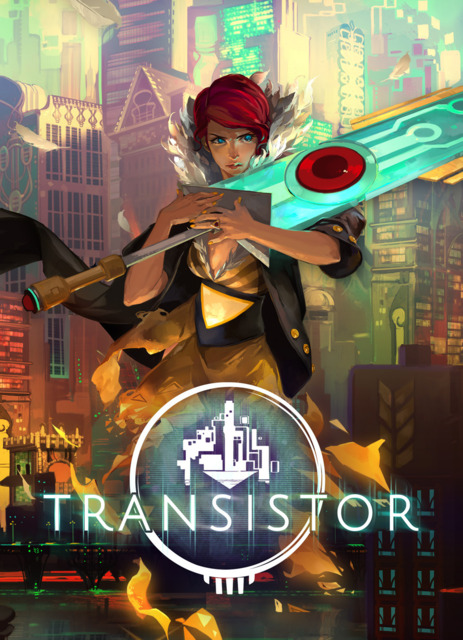
4 Comments